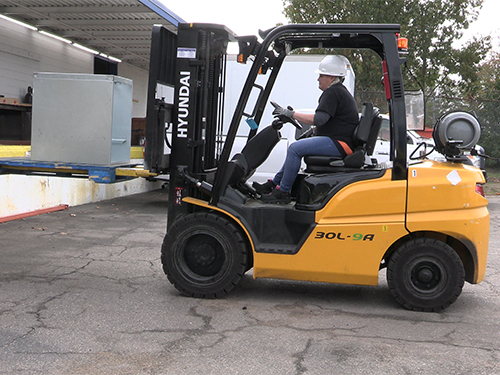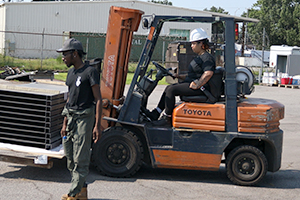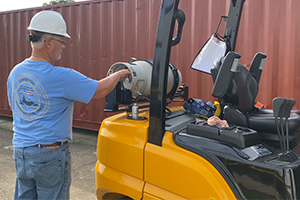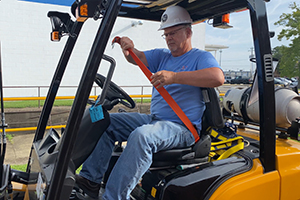Forklift Operator – 2 Days

COURSE LENGTH: 2 DAYS (16 HOURS)
COURSE LOCATIONS: Norfolk VA, National City CA
This training provides familiarity in forklift types, forklift safety, pre/post-use inspections and operations. Upon completion of training, students will be certified to operate forklifts of specific types and capacities.
COURSE OBJECTIVES
REFERENCES
- ANSI/ITSDF B5601, CID A-A-50271, CS202-56(1961)
- DHHS (NIOSH) publication No. 2001-109 (2001, June), Directive STD 01-110003 (STD1-11-11.3) (1978,October)
- FED-STD-595, Color No.13538 & 15092 or NAVSUP WSS, 49 CFR 170 through 179, NAVFACP-300 (series) & 307
- NAVSUP OPS & SW023-AH-WHM-010, NFPA 505
NSTM S9086-T4-STM-010/CH-589(afloat), OPNAV INST 5100.23, Overhead Guards, Pubs 538; Chapters 4, 5, & 8, Powered Industrial Trucks - Truck Operations/OSHA, Safety Guard Rails ANSI/SIA A92.5 & A92.6, SLEP PROGRAM
- 29 CFR 1910.30(a)(3); 1910.176(a); 1910.178 [(c) (table 1 overhead guards, load back rest extensions), (I), (m), & (q); (3), (6), & (7)], 29 CFR 1915.12 (a) (2), 29 CFR 1917.1, 29 CFR 1918.1, and 29 CFR 1926.602
FUNCTIONS – Students are required to maneuver, stack, un-stack, raise, and lower various pallets. Maneuvering will include an obstacle course. forward and reverse travel, demonstrate the correct direction to travel with and without a load up and down a ramp. The student must show proper requirements for entering a blind corner, passageway, building, or loading dock door.

FORKLIFT TYPES AND CLASSES
Provides the fundamentals, understanding the workplace and knowing your equipment.

INSPECTIONS
Understanding OSHA requirements, when to remove from service and maintenance.

OPERATION
Covers stability (triangle, longitudinal, lateral, dynamic) and load handling.
Type of Forklifts – Understand the different types of forklifts and which type is best suited for the job.
Principles – Recognize the principles and apply them to the forlift being operated.
Stability Triangle – Fathom the stability triangle and apply it to the load being lifted.
Longitudinal/Lateral/Dynamic Stability – Understand each topic and how they affect the travel of the forklift.
Pre-Operation Inspection – Remember to complete the checklist before operating a forklift.
Operational Inspection – Remember to complete this inspection before operating a forklift daily.
Operating the Forklift: Traveling and Maneuvering – Be aware of travel speeds with and without a load. Understand how a forklift responds different with and without a load.
Operating the Forklift: Load Handling – Be mindful of fork positions at all times when handling a load.
Steering, Turning, and Changing Direction – Understand how a forklift steers, turns, and changes directions.
Forklift Loading Limits – Know the weight of the item(s) being handled by the forklift.
Traveling on Ramps and Grades – Grasp the concept of which way to travel with or without a load traveling on a ramp.
Maintenance – Understand when a forklift needs to be removed from service for maintenance.
Parking – Being aware of surroundings when parking a forklift, making sure forks are in the correct position.
Performance Review Evaluate for Remediation – Display their ability to give their best effort with each task presented through hands-on training.
Instructor Responsibilities – This position has no supervisory responsibilities
Reporting Relationship – Will report to assigned supervisor
Qualifications – None
Working Conditions – This position is considered SHOP/OUTDOORS which is characterized as follows.
- Primarily outdoors during the day
- Frequently working on or near moving equipment and vibrating equipment
- Humidity is frequently above 90%
- Noise is over 85 decibels
- Light is intense/glare
- Occasional exposure to open fire/flames/sparks
- Frequent exposure to airborne dust, fumes, and gases
- Work surface is stable
- Requires working in very hot (above 90 F degrees) or very cold (below 32 F degrees) temperatures
